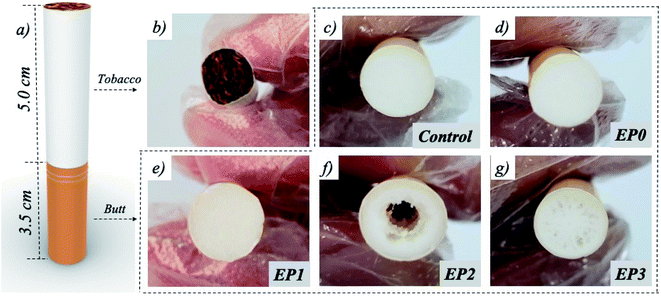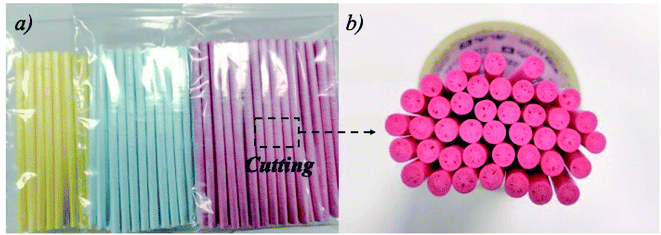 Open Access Article
Open Access ArticleNovel lightweight open-cell polypropylene foams for filtering hazardous materials
Fei Wu†
ab,
Pengke Huang†ab,
Haibin Luoa,
Jin Wangc,
Bin Shen *ab,
Qian Rena,
Pei Hec,
Hao Zhengab,
Liyang Zhangd and
Wenge Zheng*ab
*ab,
Qian Rena,
Pei Hec,
Hao Zhengab,
Liyang Zhangd and
Wenge Zheng*ab
aNingbo Key Lab of Polymer Materials, Ningbo Institute of Materials Technology and Engineering, Chinese Academy of Sciences, Ningbo, Zhejiang province 315201, China. E-mail: shenbin@nimte.ac.cn; wgzheng@nimte.ac.cn
bUniversity of Chinese Academy of Sciences, Beijing, 100049, China
cYunnan Key Laboratory of Tobacco Chemistry, Research and Development Center, China Tobacco Yunnan Industrial Co., Ltd., Kunming, 650231, China
dPetrochemical Research Institute of Petrochina, Beijing, 100049, China
First published on 6th May 2020
Abstract
Owing to the problems existing in traditional technologies for preparing commercial cellulose acetate (CA) cigarette filters, such as complex processing and chemical solution usage, novel lightweight polypropylene (PP) foams with similar geometries but different porous structures were designed and successfully prepared as filters for potentially hazardous materials via supercritical CO2 (scCO2) extrusion foaming technology without the use of any harmful chemical reagents and the problems of floating micro-nano fibers. Interestingly, the results showed that the PP foams with a flower-like/bamboo-like foamed structure not only possess modest draw resistance of 2625 Pa to maintain the smoking mouthfeel, but also show modest filtering performance, as some of the smoke constituents such as tar, nicotine, and benzo[a]pyrene (B[a]P) of the sample are similar to that of the commercial CA cigarette filters, suggesting its excellent potential as the next-generation cigarette filters. Moreover, the formation mechanism of different foam structures as well as the mechanism of the cigarette smoke transport in such PP foams is discussed.
1. Introduction
Tobacco is a commodity that is unnecessary in life but has become an object of almost universal consumption, and is therefore a proper subject of taxation.1 However, cigarette smoke is a complex mixture of thousands of chemical compounds, including numerous mutagens, carcinogens and other toxicants, which is the main cause of lung cancer and other diseases.2,3 Therefore, in order to reduce the harm from cigarette smoke and harmful micro-particles to human health, it is quite necessary to develop outstanding adsorption technologies for smoke filters.4,5 Nowadays, most of the cigarette butts consist of cellulose acetate (CA) due to its excellent adsorption and filtration performance. Nevertheless, traditional technologies for preparing CA filters are not only complicated and time-consuming (Fig. 1a) but also require chemical solvent addition during the tow band production and coating process, which is harmful to human health.6,7 Furthermore, the above mentioned CA filters are expensive, and more importantly, some micro-filters may be inhaled into the respiratory tract through high-temperature smoke and may cause cancer.8 In addition, according to the review of S.A. Wilson and S. Marinello, CA used in the cigarette butts possesses poor photo- and bio-degradable properties due to the additional acetyl group, high molecular weight and crystallinity.9,10 Moreover, the consumption of tobacco-containing CA filters generates tons of cigarette butt waste annually, which is difficult to dispose. Another common cigarette butt material is polypropylene (PP), which is one of the most popular resins in the world owing to its cheapness, excellent performance, and high availability.11–13 Besides, PP resins are easily recycled through a melting process while CA requires the treatment of plasticization before melt processing. However, problems do exist with the traditional technologies for preparing PP fiber filters, such as complex processing and chemical solution usage. Therefore, it is of great significance to design novel PP-based cigarette filters and obtain relevant low-cost, harmless and eco-friendly preparation technologies.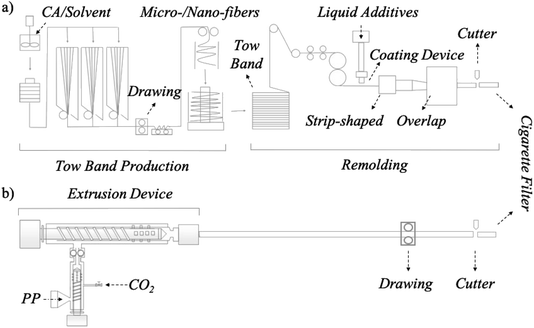 | ||
| Fig. 1 Schematic illustration of the preparation of the cigarette filters: (a) traditional method, (b) supercritical CO2 extrusion foaming technology. | ||
Generally speaking, the structure of the material determines its features, and supercritical CO2 (scCO2) foaming can endow the material with diverse structures. In comparison with traditional technologies for cigarette-filter fabrication, the scCO2 foaming technology is more environmentally friendly, time-saving and productive (see Fig. 1b).14 Furthermore, the scCO2 foaming technology is constantly innovating, and the obtained products with special structures are expanding as well. For example, biomimetic PP foam strips with tunable hierarchical tubular porous structure have been proposed, and they can exhibit both absorption and filtration ability during the oil–water separation in which the oil can be absorbed in seconds while the deionized water is filtered quickly through the foam strips.15 Inspired by these facts, we believe that the novel structural design of PP foams coupled with the scCO2 foaming technology can be a feasible way for fabricating the next-generation cigarette filters.
Herein, novel lightweight PP foams with similar geometries but different porous structures were designed and successfully prepared as filters for potentially hazardous materials via scCO2 extrusion foaming technology (SEF) without the use of any harmful chemical reagents and the problems of floating micro-nano fibers. Interestingly, the results show that the PP foam with a flower-like/bamboo-like foamed structure could exhibit a good balance between the mouthfeel of cigarette smoke and the filtering effect since it possesses a modest draw resistance of 2625 Pa and a modest filtering performance closest to that of the trade CA cigarette filters, suggesting its excellent potential for the next-generation cigarette filters. Moreover, the formation mechanism of different foam structures as well as the mechanism of the cigarette smoke transport in such PP foams is discussed.
2. Experimental section
2.1 Materials
Commercially high-melt-strength branched polypropylene resin (HMS-PP, grade HMS1602) and polypropylene homopolymer (grade T03) were purchased from China Petroleum and Chemical Corporation and Sinopec Zhenhai Refining & Chemical Company, respectively. The polyolefin elastomer (POE, grade 8150) used in this study was provided by Dow Chemical Investment Co., Ltd. The physical blowing agent, CO2 (99% purity), was obtained from Ningbo Wanli Gas Corporation. Tobacco (YUXI(soft), a commercially produced cigarette by China Tobacco Yunnan Industrial Co., Ltd.), Cambridge filters (F319-04, Whatman) and commercial cellulose acetate (CA) cigarette butts (YUXI grade 4000 Pa) were provided by China Tobacco Yunnan Industrial Co., Ltd.2.2 Fabrication of PP foams with different structures
Numerous factors will affect the final foam structure in the actual production process such as machine, materials, additives, processing temperature, pressure, gas content, drawing speed, room temperature, humidity and so on. Therefore, it is unrealistic to fully describe the detailed process steps of all the samples. However, the preparation processes of the hollow,15 relatively closed-cell16,17 and open-cell structures18 were similar to our previous works, and more details about the samples and equipment could be found. Besides, the materials used in this study are shown in Table 1, and the key steps for the preparation of the different structures are illustrated in Fig. 3. For example, the PP resins and additives (Table 1) were fed into a tandem single screw extruder, which consisted of two extruders, an ISCO syringe pump to inject CO2 (fixing at 3 wt% of the polymer melt) into the PP melts, a heat exchanger for better mixing and a 2.0 mm nozzle for extrusion foaming. Besides, different temperatures and external drawing forces were also adjusted to maintain similar geometries (cylinder with a diameter of 7.6 ± 0.1 mm). In general, the first extruder was used to plasticize the polymers and preliminarily mix the scCO2 with the melt, and the experimental conditions were set at the same settings as for EP2 and EP3, that is, rotating speed at 36 rpm and processing temperature at 190 °C. On the other hand, the second extruder can provide the initial cooling of the polymer/scCO2 melt, whereby the melting temperature can highly influence the foaming behavior of the polymer. Hence, the temperature of the second extruder was set at a lower temperature compared to the first extruder. The EP2 sample was collected at the melting temperature of 181 °C while the EP3 sample was collected at the melting temperature of 178 °C. Moreover, in order to make the size of the samples consistent with the requirements, the as-prepared polymer foams were forced to deform parallel to the direction of the second extruder by using the drawing device (LQ-500 high-speed drawing machine) with a pulling speed of 600–800 rpm (depending on the actual size of the foam strips).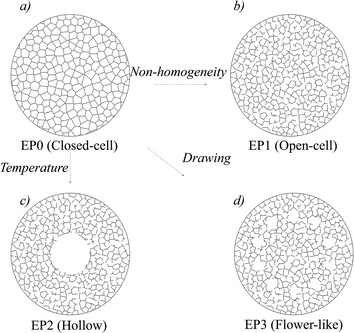 | ||
| Fig. 3 The schematic figuration of the different structures and corresponding key factors for the various material manufacture. | ||
2.3 Characterizations
To characterize the morphology of the control samples and lightweight PP foams with various structures, scanning electron microscopy (SEM) was performed on Zeiss EVO18. The open-cell content (OC) of the foams was estimated using AccuPycII1340 FoamPyc based on the Clapeyron–Clausius equation. A linear smoking machine (SM450) was used to capture cigarette smoke, and Cambridge filters within the smoking machine are commonly used to capture total particulate matter (TPM) in mainstream smoke according to ISO 6565:2002. Besides, Fourier transform infrared spectroscopy (FTIR, ANTARIS II) was used to determine the chemical constituents of cigarette smoke captured with Cambridge filters.3. Results and discussion
Lightweight PP foams with similar geometries but different porous structures were successfully prepared via the scCO2 extrusion foaming technology (Fig. 1b), and they were named EP0, EP1, EP2 and EP3. In order to discover their structural characteristics in comparison with the commercial cigarette filter (named as “Control” sample), SEM of the cross-section and longitudinal-section of all the samples was conducted (Fig. 2). The traditional cigarette filter is made up of thousands of fibrous CA with a diameter of about 10 μm while the as-prepared PP foams were composed of numerous microcells. Individually, the EP0 and EP1 samples possess a homogenous cellular structure, but that of EP1 is more disordered and ruptured (EP0 has much more closed cells than EP1), indicating a higher open-cell content in the EP1 sample. Interestingly, the EP2 sample exhibits a unique hollow tubular structure where the microcells near the center were broken. More interestingly, a flower-like/bamboo-like foamed structure was present in the EP3 sample since the radially distributed pores made EP3 look like a petal in the cross-section while the longitudinally distributed nodes made it look like a bamboo in another direction.The formation mechanism of the above four foam structures is presented in Fig. 3. As we know, the foam structures are closely related to three important steps: nucleation, bubble growth and bubble coalescence.19 The closed-cell (Fig. 3a) and open-cell (Fig. 3b) cellular structure are the two common structural forms. According to the classical nucleation theory, the homogenization of PP with the dissolved gases and nucleating agent is mainly determined by a mass-transfer process.20 After that, the nucleation of cells in the PP melt can act as a center for cell growth after a pressure drop when the melt exiting the extruder dies. As for the high melt-strength (HMS) branched PP (EP0), the matrix is strong enough to withstand the bubble growth and coalescence, and the relatively closed-cell structures are formed.21 On the contrary, the key to preparing an open-cell structure is introducing non-homogeneity, that is, hard and soft region, into the polymer blends.18,22 In the EP1–EP3 samples, the HMS branched PP acts as the hard region, and the linear homopolymer PP (EP1, Table 1) or POE (EP2 and EP3, Table 1) is introduced as the soft region, which will rupture during bubble growth to form open-cell structures (Fig. 3b–d). According to our previous works,15 the radially distributed viscosity in the cross-section due to the temperature gradient resulted in a different bubble-growth rate. Hence, the radius curvature became smaller as it deviated from the center. Then, the smaller bubbles will generally diffuse into a larger bubble according to Henry's law, resulting in the formation of the hollow structure like EP2 samples. As for EP3 samples, in order to lower the Gibb's free energy maximum, the adjacent cells tend to gather together because the surface area of the cells will be decreased after bubble coalescence. On the other hand, the nucleation of cells will be greatly changed if there exists an external force, which will accelerate the cell coalescence after the die swell behavior.19,23 Therefore, the PP melt experiencing the external drawing force can help in the formation of the flower-like/bamboo-like structure (like the EP3 sample) instead of the hollow structure.
The application of the scCO2 continuous extrusion-foaming technique to fabricate PP foams as cigarette filters could greatly optimize the process without the use of any harmful chemical reagents and solve the problem of floating micro-nano fibers. Moreover, it can be massively fabricated with a speed that exceeds 0.5 m s−1. In comparison with the commercial cigarette filter, there are also several advantages with respect to the extrusion of PP foams. First, the price per ton of PP is many times cheaper than that of CA. Besides, the introduction of the cellular structure makes the materials much lighter, further reducing the cost and waste of the materials, as shown in Table 1. For instance, compared to the control sample with a similar dimension, the weight of the EP sample was significantly decreased, demonstrating the great superiority of lightweight PP foams as novel cigarette filters.
In general, cigarette filters not only play an important role in beautification (Fig. 4a–c) but also act as the core part of filtering harmful substances in cigarette smoke. The cheaper raw material and simplified fabrication process are insufficient for the replacement of original CA cigarette filters, especially when it concerns human health. Therefore, how to balance the relationship between the filtering effect and the mouthfeel of cigarette smoke is a challenging topic but a crucial one for cigarette filters. Generally speaking, the mouthfeel can be evaluated by the draw resistance according to ISO 6565:2002; too low (i.e. below 2000 Pa) or too high (i.e. above 4000 Pa) draw resistance of the samples are unwanted. Improving the filtering effect of cigarette filters will sacrifice the taste of smoke due to the high draw resistance. On the contrary, it is difficult to achieve the function of filtering for cigarette filters when the draw resistance is too small. Herein, the relationships between the cellular structure, the draw resistance and the filtering effect of cigarette smoke for lightweight PP foams with different porous structures were investigated, and all of them were made into standard samples for better simulation of actual application (Fig. 4d–g). As shown in Fig. 5a and b, the draw resistance of EP0 was as high as 23![[thin space (1/6-em)]](https://www.rsc.org/images/entities/char_2009.gif) 375 Pa due to its relatively closed-cell structure with an open-cell ratio of only 86%, and that of EP2 was too low due to the introduction of a large hollow structure. Though possessing an open-cell ratio (92.4%) similar to the control sample (91.3%), EP1 still had a much higher draw resistance of 15
375 Pa due to its relatively closed-cell structure with an open-cell ratio of only 86%, and that of EP2 was too low due to the introduction of a large hollow structure. Though possessing an open-cell ratio (92.4%) similar to the control sample (91.3%), EP1 still had a much higher draw resistance of 15![[thin space (1/6-em)]](https://www.rsc.org/images/entities/char_2009.gif) 030 Pa, indicating that merely adjusting the open-cell ratio was not enough to develop novel cigarette filters. However, EP3 with the flower-like/bamboo-like foamed structure possessed a modest draw resistance of 2625 Pa (close to the commercial Control sample), possibly owing to its high open-cell ratio of 93.8% as well as the presence of tiny hollow structures and nodes.
030 Pa, indicating that merely adjusting the open-cell ratio was not enough to develop novel cigarette filters. However, EP3 with the flower-like/bamboo-like foamed structure possessed a modest draw resistance of 2625 Pa (close to the commercial Control sample), possibly owing to its high open-cell ratio of 93.8% as well as the presence of tiny hollow structures and nodes.
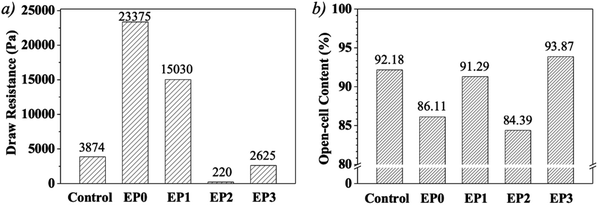 | ||
| Fig. 5 (a) The draw resistance and (b) the open-cell content are used as the measure indices of the mouthfeel of the cigarette smoke. | ||
A complex cigarette smoke containing approximately more than 4000 chemical constituents would be produced during smoking, and hence the filtering effect of cigarette filters is very important.24 Nowadays, the smoking machine with Cambridge filters is commonly used to simulate the process of human smoking (Fig. 6a) in which the Cambridge filter is equivalent to human lungs, and the smoke after passing through the cigarette filter would be intercepted by the filter paper.25–27 For cigarettes that primarily burn tobacco, the degree of the Cambridge filter (Fig. 6g) discoloration is proportional to the smoke captured by the filter paper. As exhibited in Fig. 6c and d, the color of the Cambridge filter for the EP1 sample was slightly deeper than that of the EP0 sample because of the higher open-cell ratio, but both of them were very light, indicating that their filtering performance was very good due to the ultra-high draw resistance. However, for the EP2 sample (Fig. 6e), there was a dark brown color in the center of the Cambridge filter due to an ultra-high throughput resulting from its internal hollow structure, which clearly suggest poor filtering performance. Interestingly, the similar color change of the EP3 and Control sample can be seen in Fig. 6b and f, which indicates that EP3 possesses a modest filtering performance similar to that of the commercial cigarette filters.
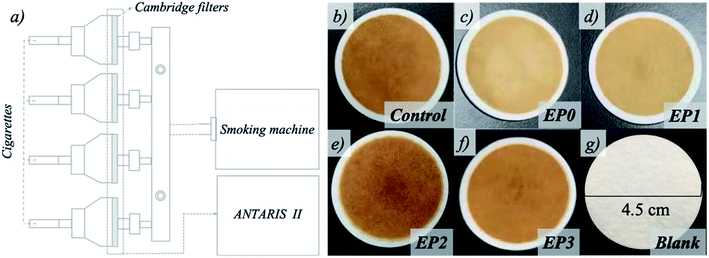 | ||
| Fig. 6 (a) Schematic diagram of the smoking machine, and (b–f) the mainstream smoke after passing through the different filters are collected in the Cambridge filters. (g) Blank Cambridge filter. | ||
Since cigarette smoke is a complex mixture of several thousand compounds, it is difficult to analyze all of them. Therefore, several smoke constituents were selected for analysis, and they have been identified by the public health community as compounds that may contribute to risks associated with cigarette smoking. Besides, the total particulate matter (TPM) is also an important indicator for measuring the filtration effect of cigarette smoke.28,29 As shown in Table 2, because of the ultra-high suction resistance, the values of harmful smoke constituents and the TPM values for EP0 and EP1 samples were beyond the measuring range of the instruments, indicating the unpleasant user experience during smoking. As predicted, these values for the EP2 sample were higher than the Control and EP3 samples owing to its poor filtering performance. For example, compared to the control sample, the phenol, TPM and NH3 in the EP2 sample increased by 8.08 μg per cig, 3.15 μg per cig and 2.49 μg per cig, respectively. In contrast, even though the smoke constituents such as phenol, TPM and NH3 in the EP3 sample increased by 4.17 μg per cig, 1.37 μg per cig and 1.94 μg per cig, respectively, the other constituents such as tar, nicotine and benzo[a]pyrene (B[a]P) increased only by −0.08 mg per cig, 0.11 mg per cig and 0.34 ng per cig, respectively. Besides, the color change of the Cambridge filters of EP3 was similar to that of the control sample, suggesting that the filter performance of the EP3 sample is much closer to that of the control sample than EP2.
| Sample | B[a]P, ng per cig | NNK, ng per cig | NH3, μg per cig | Phenol, μg per cig | CO, mg per cig | Tar, mg per cig | Nicotine, mg per cig | TPM, μg per cig |
|---|---|---|---|---|---|---|---|---|
| a “TPM”, total particle matter; “N/A”, not applicable. | ||||||||
| Control | 8.47 | 5.91 | 6.77 | 12.19 | 11.99 | 9.70 | 1.08 | 11.85 |
| EP0 | N/A | N/A | N/A | N/A | N/A | N/A | N/A | N/A |
| EP1 | N/A | N/A | N/A | N/A | N/A | N/A | N/A | N/A |
| EP2 | 9.94 | 6.32 | 9.26 | 20.27 | 14.77 | 11.41 | 1.28 | 15.00 |
| EP3 | 8.81 | 7.09 | 8.71 | 16.36 | 15.49 | 9.62 | 1.19 | 13.22 |
Fig. 7 schematically illustrates the mechanisms of the cigarette smoke transport in the EP3 sample with the flower-like/bamboo-like foamed structure. The bamboo-like structure in the longitudinal-section could act as airflow transportation channels that could guarantee the mouthfeel of smoke while the smoke dissipation path can be obviously increased due to both the nodes and open-cell structures.30,31 Besides, the three-dimensional interconnected highly open-cell porous structure of EP3 can increase the surface area of the material and improve the contact area of the mainstream cigarette smoke,32 thereby improving the filtering performance. Moreover, it can be predicted that the addition of functional additives can greatly improve its filtering effect and its aesthetics. For example, more colorful filters can be developed after adding the plastic color masterbatch, as shown in Fig. 8. Last but not the least, the above interesting structure will not be limited to cigarette filters, and more interesting research still need to be carried out. In summary, novel lightweight PP foams with flower-like/bamboo-like foamed structures have the greatest potential to replace traditional cigarette filters through further development based on the above experiments and analyses. Nevertheless, smoking is harmful to our health; considering our health and that of the people we care about, please do not smoke.
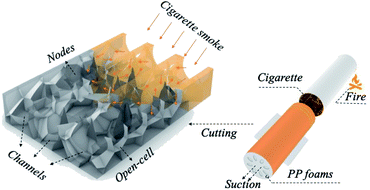 | ||
| Fig. 7 Schematic illustration of the filtration of the harmful ingredients in the cigarette smoke using the as-prepared lightweight PP foams with flower-like/bamboo-like structure as a novel filter. | ||
4. Conclusions
In conclusion, the work described here demonstrates a one-step, low-cost, harmless and scalable process to fabricate lightweight polypropylene (PP) foams as filters for novel hazardous materials via the supercritical CO2 extrusion foaming technology, which can greatly improve the drawbacks like the overuse of harmful chemical reagents and the problems of floating micro-nano fibers in the commercial cigarette filter process. Besides, as for the cigarette butt, the filter performance also plays an important part. However, improving the filtration efficiency of the cigarette filter will sacrifice the taste of the smoke, which can be reflected by the draw resistance to a certain extent. Hence, several porous structures like the relatively closed-cell, open-cell, hollow, and flower-like/bamboo-like structures were designed and prepared to balance the requirement of the mouthfeel and the filtration performance of the cigarette smoke. Interestingly, the results showed that the PP-based cigarette filters with flower-like/bamboo-like foamed structure, not only expressed a modest draw resistance of 2625 Pa to maintain the smoking mouthfeel but also showed a modest filtering performance as some of the smoke constituents such as tar, nicotine and benzo[a]pyrene (B[a]P) in the sample were similar to that of the commercial CA cigarette filters, indicating its excellent potential for the next-generation cigarette filters. Furthermore, the formation mechanism of different foam structures as well as the mechanism of the cigarette smoke transport in such PP-based foams is discussed.Conflicts of interest
There are no conflicts to declare.Acknowledgements
The authors are grateful to the financial supports from S&T Innovation 2025 Major Special Programme of Ningbo (2018B10044), National Natural Science Foundation of China (51603218) and Natural Science Foundation of Ningbo (2018A610004). We also acknowledge the China Tobacco Yunnan Industrial Co., Ltd. for a grant in support of this work, and for technical advice and data.References
- A. Smith, The wealth of nations, Penguin, 1776 Search PubMed.
- A. Csordas and D. Bernhard, Nat. Rev. Cardiol., 2013, 10, 219–230 CrossRef CAS PubMed.
- A. Chen, Y. Li, Y. Yu, Y. Li, L. Zhang, H. Lv and L. Liu, RSC Adv., 2015, 5, 107299–107306 RSC.
- C. Liu, Y. DeGrandpré, A. Porter, A. Griffiths, K. McAdam, R. Voisine, F. Côté and C. Proctor, Food Chem. Toxicol., 2011, 49, 1904–1917 CrossRef CAS PubMed.
- H. Souzandeh, Y. Wang and W. H. Zhong, RSC Adv., 2016, 6, 105948–105956 RSC.
- S. Akiko and K. Hiroki, PCT/JP2014/001449, 2014.
- K. Katsuo and A. Masaharu, PCT/JP2014/069195, 2014.
- B. Harris, Tobac. Contr., 2011, 20, 10 CrossRef PubMed.
- J. Puls, S. A. Wilson and D. Hölter, J. Polym. Environ., 2011, 19, 152–165 CrossRef CAS.
- S. Marinello, F. Lolli, R. Gamberini and B. Rimini, J. Hazard. Mater., 2020, 384, 121245 CrossRef CAS PubMed.
- E. Richaud, B. Fayolle and P. Davies, Tensile properties of polyproylene fibers, Woodhead Publishing, 2018 Search PubMed.
- H. Wang, J. Wei, S. Li, Y. Chen, Z. Ren and S. Qiu, J. Polym. Res., 2013, 20, 44 CrossRef.
- P. K. Huang, F. Wu, B. Shen, H. Zheng, Q. Ren, H. B. Luo and W. G. Zheng, Composites, Part B, 2020, 190, 107927 CrossRef CAS.
- M. Sauceau, J. Fages, A. Common, C. Nikitine and E. Rodier, Prog. Polym. Sci., 2011, 36, 749–766 CrossRef CAS.
- P. K. Huang, F. Wu, B. Shen, X. H. Ma, Y. Q. Zhao, M. H. Wu, J. Wang, Z. H. Liu, H. B. Luo and W. G. Zheng, Chem. Eng. J., 2019, 370, 1322–1330 CrossRef CAS.
- P. K. Huang, M. H. Wu, Y. Y. Pang, B. Shen, F. Wu, X. Q. Lan, H. B. Luo and W. G. Zheng, Composites, Part A, 2019, 116, 180–186 CrossRef CAS.
- P. K. Huang, F. Wu, Y. Y. Pang, M. H. Wu, X. Q. Lan, H. B. Luo, B. Shen and W. G. Zheng, Compos. Sci. Technol., 2019, 171, 282–290 CrossRef CAS.
- S. S. Wang, K. Wang, Y. Y. Pang, Y. Li, F. Wu, S. Wang and W. G. Zheng, J. Appl. Polym. Sci., 2016, 133, 43812 Search PubMed.
- S. T. Lee and C. B. Park, Foam extrusion: Principles and practice, CRC Press, 2000 Search PubMed.
- D. Mao, J. R. Edwards and A. Harvey, Prediction of foam growth and its nucleation in free and limited expansion, Chem. Eng. Sci., 2006, 61, 1836–1845 CrossRef CAS.
- R. Jiang, Y. Chen, S. Yao, T. Liu, Z. Xu, C. B. Park and L. Zhao, Polymer, 2019, 179, 121628 CrossRef CAS.
- T. Kuang, F. Chen, L. Q. Chang, Y. N. Zhao, D. J. Fu, X. Gong and X. F. Peng, Chem. Eng. J., 2017, 307, 1017–1025 CrossRef CAS.
- A. Wong, Y. Guo and C. B. Park, J. Supercrit. Fluids, 2013, 79, 142–151 CrossRef CAS.
- E. Pinto, M. Cruz, P. Ramos, A. Santos and A. Almeida, J. Hazard. Mater., 2017, 325, 31–35 CrossRef CAS PubMed.
- C. G. G. M. Pauwels, W. N. M. Klerx, J. L. A. Pennings, A. W. Boots, F. J. van Schooten, A. Opperhuizen and R. Talhout, Chem. Res. Toxicol., 2018, 31, 462–471 Search PubMed.
- M. F. Borgerding, J. A. Bodnar, H. L. Chung, P. P. Mangan, C. C. Morrison, C. H. Risner, J. C. Rogers, D. F. Simmons, M. S. Uhrig, F. N. Wendelboe, D. E. Wingate and L. S. Winkler, Food Chem. Toxicol., 1998, 36, 169–182 CrossRef CAS PubMed.
- C. Watson, J. McCraw, G. Polzin and D. Ashley, Environ. Sci. Technol., 2004, 38, 248–253 CrossRef CAS PubMed.
- G. Q. Gu, C. B. Han, C. X. Lu, C. He, T. Jiang, Z. L. Gao, C. J. Li and Z. L. Wang, ACS Nano, 2017, 11, 6211–6217 CrossRef CAS PubMed.
- M. Lee, G. P. Kim, H. Don Song, S. Park and J. Yi, Nanotechnology, 2014, 25, 345601 CrossRef PubMed.
- H. Liu, C. Cao, J. Huang, Z. Chen, G. Chen and Y. Lai, Nanoscale, 2020, 12, 437–453 RSC.
- X. Liu, H. Souzandeh, Y. Zheng, Y. Xie, W. H. Zhong and C. Wang, Compos. Sci. Technol., 2017, 138, 124–133 CrossRef CAS.
- X. Zhao, L. P. Chen, Y. Guo, X. Ma, Z. Y. Li, W. Ying and X. S. Peng, Applied Materials Today, 2019, 14, 96–101 CrossRef.
Footnote |
| † These authors contributed equally to this work. |
| This journal is © The Royal Society of Chemistry 2020 |



